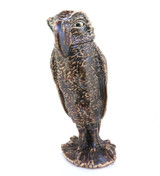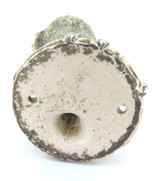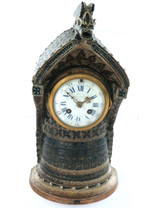Description
Rare Antique Signed Martin Bros Stoneware Grotesque Bird circa 1890-1899
Harrington & Co are pleased to present the following piece of genuine Martinware from a privately owned collection we have recently acquired. This could be your opportunity to own a prized piece of artistic, studio pottery from the infamous Martin brothers. This particular piece from the collection is an exceptionally rare, Martin Brothers bird. Decorated in a Grotesque style with a sly yet almost comedic expression, peering out from hooded eyes, the bird is very expressive. The salt wash is an extraordinary, mottled bronze, sand to brown shade with an intricate feather like pattern. The head levers off to reveal a hollow interior inside. The bird would have been fixed to a wooden platform, this is missing in this instance. There are two holes in the base to carefully affix the bird to a base, if wished by the new owner. The skill of Robert's moulding of the clay is very evident in the attention to detail and artistic flourishes. The bottom section of the birds head is incised with R.W. Martin Bros and London Southall but unfortunately no date. Other similar pieces were made around 1890 - 1899. The condition of this stunning Martin Bros bird is excellent, it is very well preserved and the form is entirely intact. A fantastic piece to collect and a true pièce de résistance.
The Martin Brothers manufactured pottery in London between 1873 and the early 20th century during a time of great change. The brothers moved away from the highly decorative Victorian ceramics to a more figural, timeless, experimental style. The four brothers, Robert, Charles, Walter and Edwin Martin were pioneers in art pottery, in modern terms however, Martinware is considered to be more studio pottery. The pottery production was very much a family affair with all the brothers playing their part. Although mainly self taught, Robert studied under J.B Philips, an architectural sculptor and Alexander Munro in 1861 who introduced him to some very influential writers, philosophers and artists of the time. He later took drawing classes at the Lambeth School of Art, where his two brothers, Walter and Edwin also later studied. Charles Martin mainly managed the shop, though often found it difficult to sell the pottery and was just as delightfully eccentric as his brothers.
The Martin brothers produced a very distinct type of salt glazed stoneware until the closure of their studio in 1914. The eldest brother Robert Wallace Martin, continued to produce some pieces of pottery until his death in 1923. Martin Brothers stoneware included both vessels and sculptural figures. Exhibitions and catalogues of works show the true extent and range of their experimentation, whilst their more famous pieces showcase, the brothers at their most esoteric and loveable. Although they were arguably best known for their bird sculptures, vessels adorned with creatures and caricatured, grotesque faces; their work also included nature inspired glazes, Japanese influences and art nouveau inspired work. The bird sculptures have become very covetable and are known as the 'Wally Birds' In the usual Martin brothers style these birds had exaggerated talons, beaks and fierce yet comical eyes.
The pottery characters and mugs, jars, vases and spoon warmers the brothers created were primarily moulded out of salt glazed stoneware clay. This material had previously been used for sewer pipes in the greater London area. The three brothers produced experimental art with the clay. Their technique required the pottery to be fired at a high temperature with salt thrown into the kiln to create the ceramic glaze. Once the salt fused with the clay at high temperatures the resulting glaze was either glossy or a matt surface finish. The results were unexpected and unknown and very much dependable on the kiln temperature on the day.
Salt glaze brings out wonderful hints of grey with beautiful greens, blues and softer browns. These colours are very representational of Martinware pottery. As the kilns were only able to be fired up occasionally and pots were often coming into direct contact with the flames, the results were very unpredictable. Sometimes only two or three items would survive the firing process. This undoubtedly caused much anguish for the brothers but helped to create the uniqueness of their work.
There was a renewed interest in Martinware after Richard Dennis an art dealer in London, organised an exhibition at Sotheby's Belgravia in 1978. Martinware can be found in museum collections and remains highly collectable, with a record being set in 2015 by a 35 cm high Wally bird jar selling for US$196,000 at auction. That particular bird jar was created in 1889, it was thought to represent Benjamin Disraeli in caricature.
Dimensions are as follows:
Height 17.5 cm x width 7 cm x depth 6 cm
Weight 341 grams
Reviews (0)
Be the first to review this product.
Additional Info
- Condition:
- Used
- Shipping:
- $49 (Fixed Shipping Cost)














